Economics Assignment - Principles of Economics, Semester 1
VerifiedAdded on 2022/09/14
|12
|2786
|12
Homework Assignment
AI Summary
This economics assignment provides solutions to four key questions. The first question explores opportunity cost using the example of Usain Bolt and analyzes the impact of petrol price increases on the hybrid car market. Question 2 examines the elasticity of demand, comparing computers and Dell computers, and calculates the impact of a price increase on egg demand. Question 3 analyzes the effects of a price ceiling and contrasts the free market with a monopoly. The final question addresses environmental issues in Australia, focusing on the impact of mining, population growth, and government policies aimed at conservation. The assignment utilizes economic theory, diagrams, and references to support its arguments, demonstrating an understanding of market dynamics and policy implications.

Running head: ECONOMICS
Economics
Name of the Student
Name of the University
Course ID
Economics
Name of the Student
Name of the University
Course ID
Paraphrase This Document
Need a fresh take? Get an instant paraphrase of this document with our AI Paraphraser
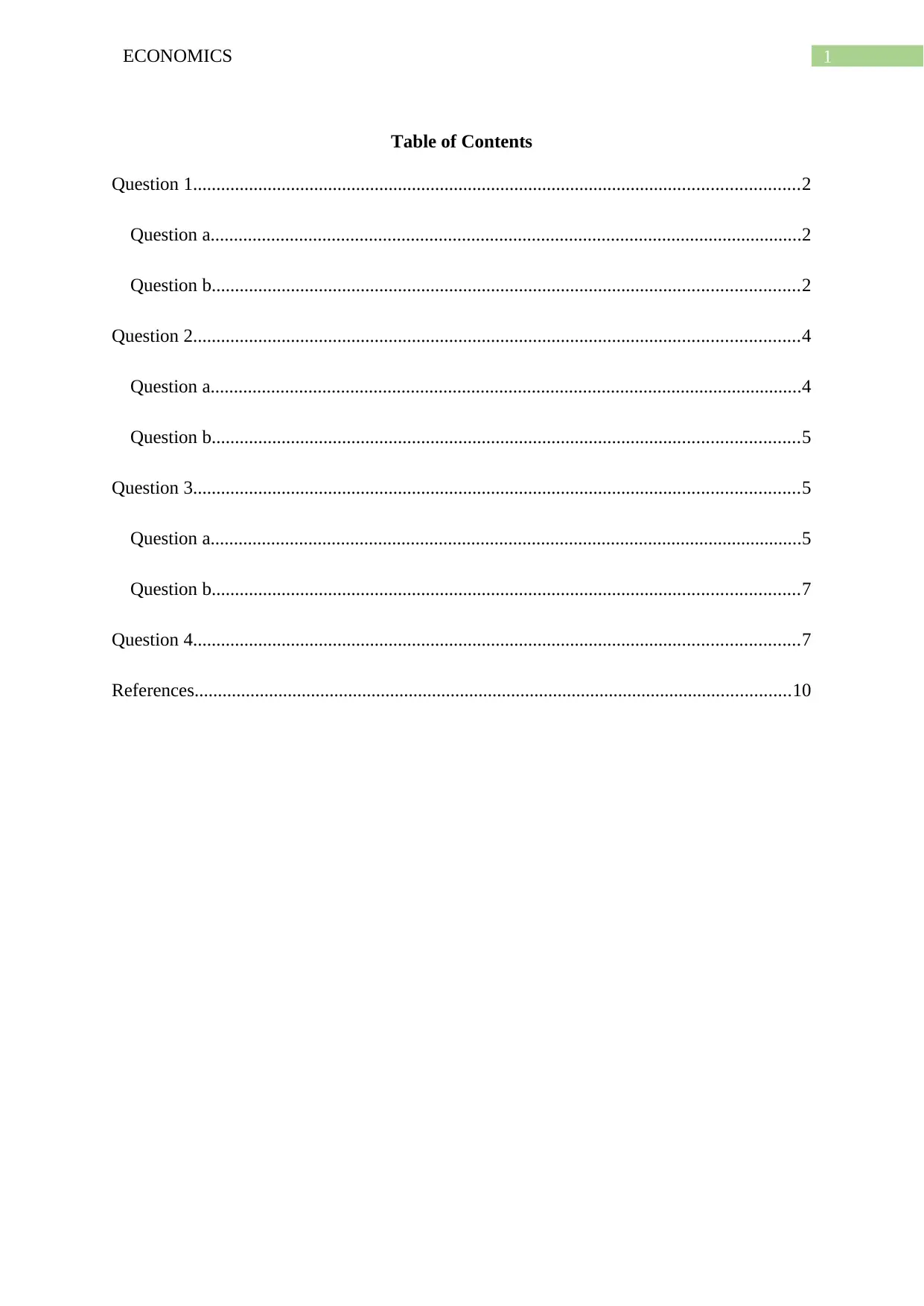
1ECONOMICS
Table of Contents
Question 1..................................................................................................................................2
Question a...............................................................................................................................2
Question b..............................................................................................................................2
Question 2..................................................................................................................................4
Question a...............................................................................................................................4
Question b..............................................................................................................................5
Question 3..................................................................................................................................5
Question a...............................................................................................................................5
Question b..............................................................................................................................7
Question 4..................................................................................................................................7
References................................................................................................................................10
Table of Contents
Question 1..................................................................................................................................2
Question a...............................................................................................................................2
Question b..............................................................................................................................2
Question 2..................................................................................................................................4
Question a...............................................................................................................................4
Question b..............................................................................................................................5
Question 3..................................................................................................................................5
Question a...............................................................................................................................5
Question b..............................................................................................................................7
Question 4..................................................................................................................................7
References................................................................................................................................10

2ECONOMICS
Question 1
Question a
Usain Bolt is the world’s fastest human. He could mow his law very quickly or at
least as well as James Bold, who mows lawns for living. Despite this fact Usain Bolt would
pay James Bold to mow his lawn rather than do it himself. The behavior of Usain Bolt can be
explained using the concepts of opportunity cost (Fine, 2016). Usain Bolt who is a
professional athlete prefer to spend time in building body or train himself. For mowing lawn,
he has to sacrifice his time that could have used to build body or training and help him to
improve his performance. For James Bold however there is no major opportunity cost for
mowing lawn he does so for living. As Usain Bolt faces a higher opportunity cost for mowing
lawn he would instead pay James to mow lawn rather than do it himself.
Question b
Hybrid cars use a small internal combustion engine as well an electric motor for
obtaining maximum power and fuel the economy with maximum emission. These are
generally more efficient compare to conventional petrol or diesel run vehicles. Hybrid cars
and petrol run cars are close substitute to each other. Hybrid cars are relatively more
expensive than petrol cars. Given all the thing, people therefore generally have petrol cars
and have a lower tendency to switch to hybrid cars. Now, an increase in price of petrol
increase cost of maintain petrol cars. This reduces the demand for petrol cars (Kreps, 2019).
As the demand for petrol car falls, people tend to shift to hybrid cars increasing the demand
for hybrid cars. An increase in demand for hybrid cars causes the demand curve for hybrid
cars to shift outward. As demand expands there is an increase in equilibrium price and
equilibrium number of vehicles available in the market for hybrid cars.
Question 1
Question a
Usain Bolt is the world’s fastest human. He could mow his law very quickly or at
least as well as James Bold, who mows lawns for living. Despite this fact Usain Bolt would
pay James Bold to mow his lawn rather than do it himself. The behavior of Usain Bolt can be
explained using the concepts of opportunity cost (Fine, 2016). Usain Bolt who is a
professional athlete prefer to spend time in building body or train himself. For mowing lawn,
he has to sacrifice his time that could have used to build body or training and help him to
improve his performance. For James Bold however there is no major opportunity cost for
mowing lawn he does so for living. As Usain Bolt faces a higher opportunity cost for mowing
lawn he would instead pay James to mow lawn rather than do it himself.
Question b
Hybrid cars use a small internal combustion engine as well an electric motor for
obtaining maximum power and fuel the economy with maximum emission. These are
generally more efficient compare to conventional petrol or diesel run vehicles. Hybrid cars
and petrol run cars are close substitute to each other. Hybrid cars are relatively more
expensive than petrol cars. Given all the thing, people therefore generally have petrol cars
and have a lower tendency to switch to hybrid cars. Now, an increase in price of petrol
increase cost of maintain petrol cars. This reduces the demand for petrol cars (Kreps, 2019).
As the demand for petrol car falls, people tend to shift to hybrid cars increasing the demand
for hybrid cars. An increase in demand for hybrid cars causes the demand curve for hybrid
cars to shift outward. As demand expands there is an increase in equilibrium price and
equilibrium number of vehicles available in the market for hybrid cars.
⊘ This is a preview!⊘
Do you want full access?
Subscribe today to unlock all pages.

Trusted by 1+ million students worldwide
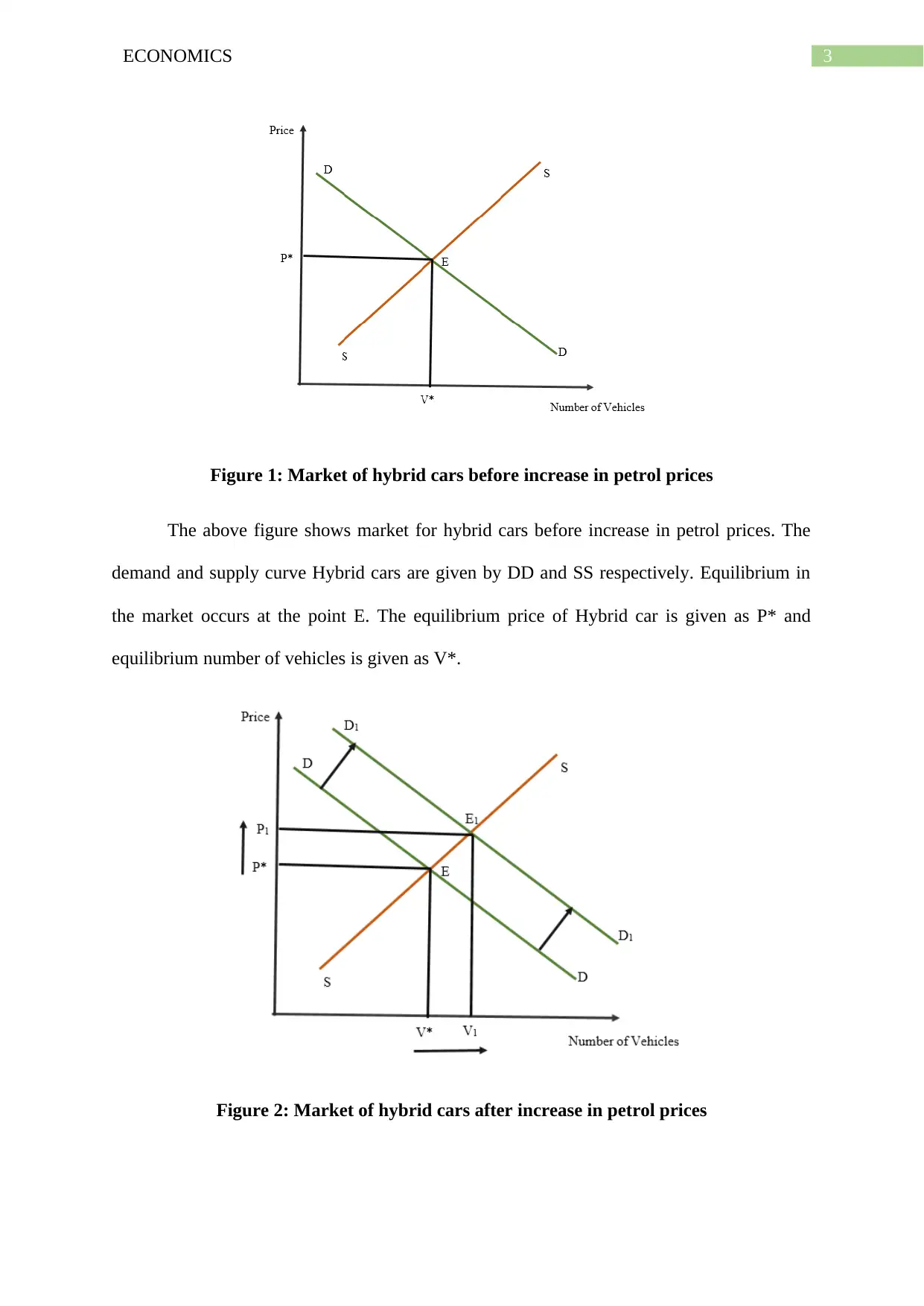
3ECONOMICS
Figure 1: Market of hybrid cars before increase in petrol prices
The above figure shows market for hybrid cars before increase in petrol prices. The
demand and supply curve Hybrid cars are given by DD and SS respectively. Equilibrium in
the market occurs at the point E. The equilibrium price of Hybrid car is given as P* and
equilibrium number of vehicles is given as V*.
Figure 2: Market of hybrid cars after increase in petrol prices
Figure 1: Market of hybrid cars before increase in petrol prices
The above figure shows market for hybrid cars before increase in petrol prices. The
demand and supply curve Hybrid cars are given by DD and SS respectively. Equilibrium in
the market occurs at the point E. The equilibrium price of Hybrid car is given as P* and
equilibrium number of vehicles is given as V*.
Figure 2: Market of hybrid cars after increase in petrol prices
Paraphrase This Document
Need a fresh take? Get an instant paraphrase of this document with our AI Paraphraser

4ECONOMICS
Now, if there is an increase in petrol price, demand for conventional vehicles that uses
petrol reduces. As people are now willing to switch to Hybrid cars demand for hybrid cars
increases (Arrow, 2015). This shifts the demand curve rightward to D1D1. The equilibrium in
the market shifts to E1. Price for hybrid cars increases to P1 and equilibrium number of
vehicles increases to V1.
Question 2
Question a
Elasticity of demand of a product measures the proportionate change in quantity
demanded of a good given the corresponding proportionate change in price. Elasticity of
demand for a product depends on different factors. One crucial factors affecting elasticity of
demand of a good is the number of available substitutes. Larger the number of available
substitutes easier it is for people to switch their demand (Cowell, 2018). This makes demand
of a product relatively more elastic. Reverse is the case for products with fewer available
substitutes. With a relatively small number of available substitutes, it is not possible for
people to adjust their demand and switch to other products because of lack of substitutes.
When demand for computers is compared to demand for Dell computers in terms of
elasticity demand for Dell computer is likely to more elastic. Number of substitute for
computers include laptop, tablet, ipad and some other things. The number of substitutes for
computer as a whole a relatively less. However, for Dell computers, there are various
competitors of Dell selling similar products. Various competitors of Dell include Intel, Hp,
Lenevo, LG, Samsung, Asus, IBM and other. Any change in price of computers does not
change the demand for computers much because of relatively less number of substitutes.
People using computers cannot easily adjust to substitute like laptops, tablets or ipad. This
indicates demand for computer is relatively less elastic. The case of Dell computers however
Now, if there is an increase in petrol price, demand for conventional vehicles that uses
petrol reduces. As people are now willing to switch to Hybrid cars demand for hybrid cars
increases (Arrow, 2015). This shifts the demand curve rightward to D1D1. The equilibrium in
the market shifts to E1. Price for hybrid cars increases to P1 and equilibrium number of
vehicles increases to V1.
Question 2
Question a
Elasticity of demand of a product measures the proportionate change in quantity
demanded of a good given the corresponding proportionate change in price. Elasticity of
demand for a product depends on different factors. One crucial factors affecting elasticity of
demand of a good is the number of available substitutes. Larger the number of available
substitutes easier it is for people to switch their demand (Cowell, 2018). This makes demand
of a product relatively more elastic. Reverse is the case for products with fewer available
substitutes. With a relatively small number of available substitutes, it is not possible for
people to adjust their demand and switch to other products because of lack of substitutes.
When demand for computers is compared to demand for Dell computers in terms of
elasticity demand for Dell computer is likely to more elastic. Number of substitute for
computers include laptop, tablet, ipad and some other things. The number of substitutes for
computer as a whole a relatively less. However, for Dell computers, there are various
competitors of Dell selling similar products. Various competitors of Dell include Intel, Hp,
Lenevo, LG, Samsung, Asus, IBM and other. Any change in price of computers does not
change the demand for computers much because of relatively less number of substitutes.
People using computers cannot easily adjust to substitute like laptops, tablets or ipad. This
indicates demand for computer is relatively less elastic. The case of Dell computers however

5ECONOMICS
is different. Because of large number of competitors any change in price of Dell computers
make a huge difference in demand (McKenzie & Lee, 2016). For example, if there is an
increase in price of Dell computers, buyers will switch their demand to computers sold by its
competitors. Similarly, a decrease in price of Dell computers attract buyers to buy more Dell
computers more. As demand for Dell computer changes more for a given change in price.
The demand for Dell computers thus is more elastic compared demand for computers.
Question b
The price elasticity of demand for eggs has been estimated to be 0.1. If price of eggs
increases by 10 percent, then demand for eggs will fall by (10 * 0.1) = 1 percent. The price
elasticity of demand for eggs is less than 1 meaning that demand is relatively inelastic in
nature. That is proportionate change in demand is relatively less than corresponding
proportionate change in price. As obtained from the estimation 10 percent increase in price of
eggs reduces demand for eggs by only 1 percent. The proportionately greater increase in price
compensate for the relative decline in sales of revenue (Baumol & Blinder, 2015). Total
revenue of producers is the product of price and quantity sold in the market. As price
increases more than contraction in sales volume total revenue of egg producers increases as a
result of increase in price of eggs.
Question 3
Question a
Under free market, price is determined from the independent forces of demand and
supply. Equilibrium outcome in the free market ensure efficient allocation of resources
balancing supply and demand in the market (Stiglitz, 2019) Government intervention in the
market through different price control measures distort market outcomes creating a mismatch
between market demand and available supply. Price ceiling refers to the government policy
is different. Because of large number of competitors any change in price of Dell computers
make a huge difference in demand (McKenzie & Lee, 2016). For example, if there is an
increase in price of Dell computers, buyers will switch their demand to computers sold by its
competitors. Similarly, a decrease in price of Dell computers attract buyers to buy more Dell
computers more. As demand for Dell computer changes more for a given change in price.
The demand for Dell computers thus is more elastic compared demand for computers.
Question b
The price elasticity of demand for eggs has been estimated to be 0.1. If price of eggs
increases by 10 percent, then demand for eggs will fall by (10 * 0.1) = 1 percent. The price
elasticity of demand for eggs is less than 1 meaning that demand is relatively inelastic in
nature. That is proportionate change in demand is relatively less than corresponding
proportionate change in price. As obtained from the estimation 10 percent increase in price of
eggs reduces demand for eggs by only 1 percent. The proportionately greater increase in price
compensate for the relative decline in sales of revenue (Baumol & Blinder, 2015). Total
revenue of producers is the product of price and quantity sold in the market. As price
increases more than contraction in sales volume total revenue of egg producers increases as a
result of increase in price of eggs.
Question 3
Question a
Under free market, price is determined from the independent forces of demand and
supply. Equilibrium outcome in the free market ensure efficient allocation of resources
balancing supply and demand in the market (Stiglitz, 2019) Government intervention in the
market through different price control measures distort market outcomes creating a mismatch
between market demand and available supply. Price ceiling refers to the government policy
⊘ This is a preview!⊘
Do you want full access?
Subscribe today to unlock all pages.

Trusted by 1+ million students worldwide
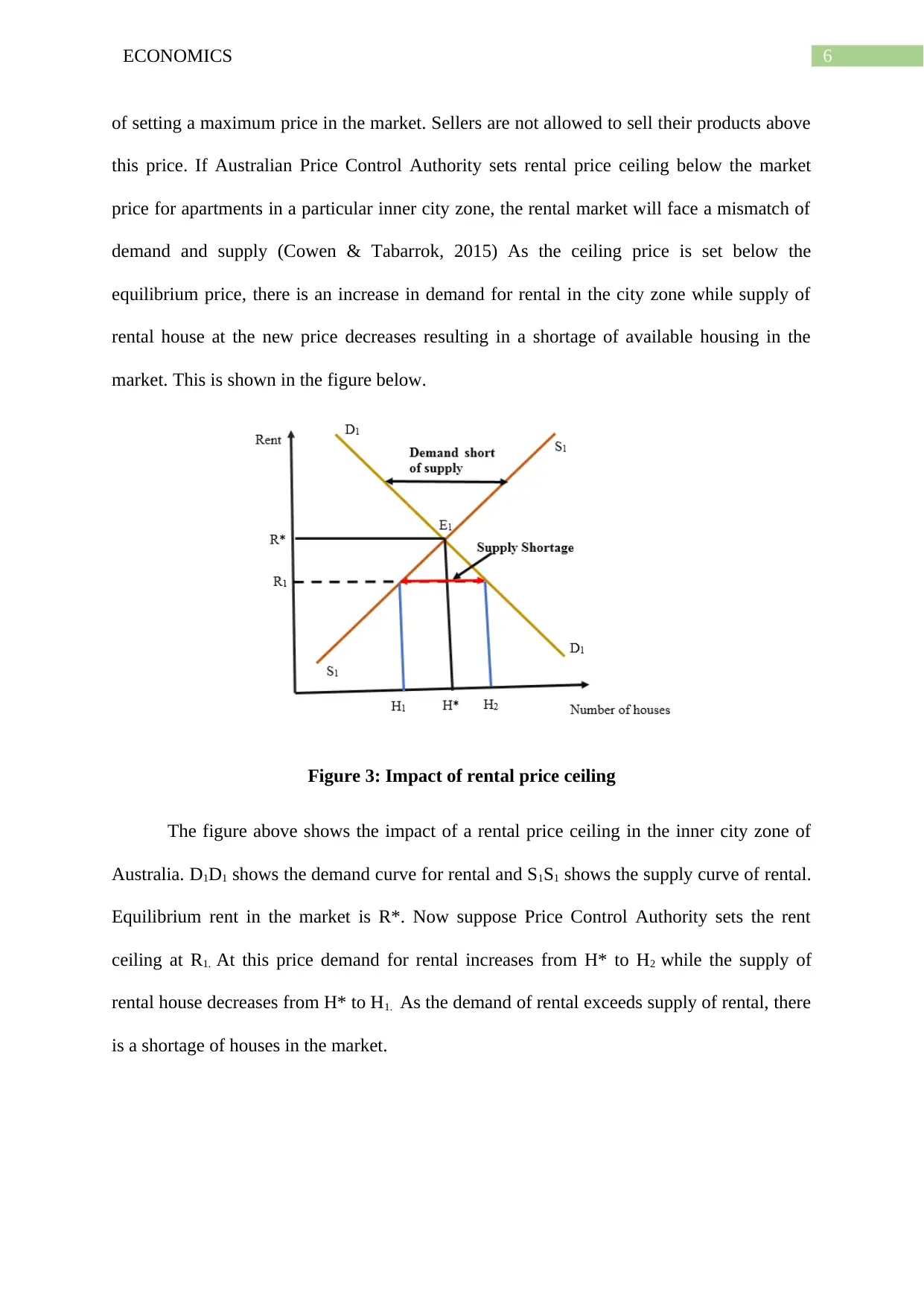
6ECONOMICS
of setting a maximum price in the market. Sellers are not allowed to sell their products above
this price. If Australian Price Control Authority sets rental price ceiling below the market
price for apartments in a particular inner city zone, the rental market will face a mismatch of
demand and supply (Cowen & Tabarrok, 2015) As the ceiling price is set below the
equilibrium price, there is an increase in demand for rental in the city zone while supply of
rental house at the new price decreases resulting in a shortage of available housing in the
market. This is shown in the figure below.
Figure 3: Impact of rental price ceiling
The figure above shows the impact of a rental price ceiling in the inner city zone of
Australia. D1D1 shows the demand curve for rental and S1S1 shows the supply curve of rental.
Equilibrium rent in the market is R*. Now suppose Price Control Authority sets the rent
ceiling at R1. At this price demand for rental increases from H* to H2 while the supply of
rental house decreases from H* to H1. As the demand of rental exceeds supply of rental, there
is a shortage of houses in the market.
of setting a maximum price in the market. Sellers are not allowed to sell their products above
this price. If Australian Price Control Authority sets rental price ceiling below the market
price for apartments in a particular inner city zone, the rental market will face a mismatch of
demand and supply (Cowen & Tabarrok, 2015) As the ceiling price is set below the
equilibrium price, there is an increase in demand for rental in the city zone while supply of
rental house at the new price decreases resulting in a shortage of available housing in the
market. This is shown in the figure below.
Figure 3: Impact of rental price ceiling
The figure above shows the impact of a rental price ceiling in the inner city zone of
Australia. D1D1 shows the demand curve for rental and S1S1 shows the supply curve of rental.
Equilibrium rent in the market is R*. Now suppose Price Control Authority sets the rent
ceiling at R1. At this price demand for rental increases from H* to H2 while the supply of
rental house decreases from H* to H1. As the demand of rental exceeds supply of rental, there
is a shortage of houses in the market.
Paraphrase This Document
Need a fresh take? Get an instant paraphrase of this document with our AI Paraphraser
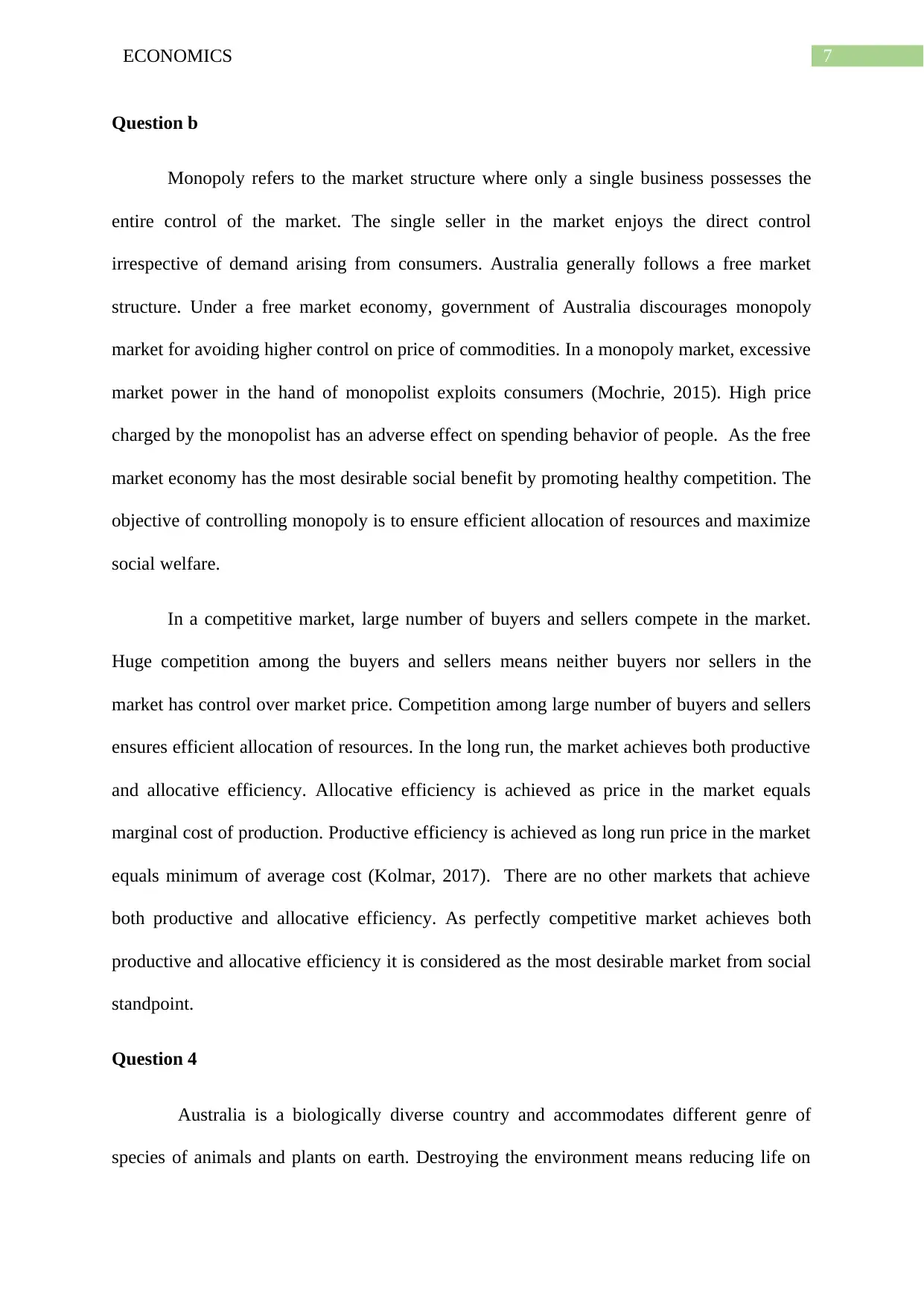
7ECONOMICS
Question b
Monopoly refers to the market structure where only a single business possesses the
entire control of the market. The single seller in the market enjoys the direct control
irrespective of demand arising from consumers. Australia generally follows a free market
structure. Under a free market economy, government of Australia discourages monopoly
market for avoiding higher control on price of commodities. In a monopoly market, excessive
market power in the hand of monopolist exploits consumers (Mochrie, 2015). High price
charged by the monopolist has an adverse effect on spending behavior of people. As the free
market economy has the most desirable social benefit by promoting healthy competition. The
objective of controlling monopoly is to ensure efficient allocation of resources and maximize
social welfare.
In a competitive market, large number of buyers and sellers compete in the market.
Huge competition among the buyers and sellers means neither buyers nor sellers in the
market has control over market price. Competition among large number of buyers and sellers
ensures efficient allocation of resources. In the long run, the market achieves both productive
and allocative efficiency. Allocative efficiency is achieved as price in the market equals
marginal cost of production. Productive efficiency is achieved as long run price in the market
equals minimum of average cost (Kolmar, 2017). There are no other markets that achieve
both productive and allocative efficiency. As perfectly competitive market achieves both
productive and allocative efficiency it is considered as the most desirable market from social
standpoint.
Question 4
Australia is a biologically diverse country and accommodates different genre of
species of animals and plants on earth. Destroying the environment means reducing life on
Question b
Monopoly refers to the market structure where only a single business possesses the
entire control of the market. The single seller in the market enjoys the direct control
irrespective of demand arising from consumers. Australia generally follows a free market
structure. Under a free market economy, government of Australia discourages monopoly
market for avoiding higher control on price of commodities. In a monopoly market, excessive
market power in the hand of monopolist exploits consumers (Mochrie, 2015). High price
charged by the monopolist has an adverse effect on spending behavior of people. As the free
market economy has the most desirable social benefit by promoting healthy competition. The
objective of controlling monopoly is to ensure efficient allocation of resources and maximize
social welfare.
In a competitive market, large number of buyers and sellers compete in the market.
Huge competition among the buyers and sellers means neither buyers nor sellers in the
market has control over market price. Competition among large number of buyers and sellers
ensures efficient allocation of resources. In the long run, the market achieves both productive
and allocative efficiency. Allocative efficiency is achieved as price in the market equals
marginal cost of production. Productive efficiency is achieved as long run price in the market
equals minimum of average cost (Kolmar, 2017). There are no other markets that achieve
both productive and allocative efficiency. As perfectly competitive market achieves both
productive and allocative efficiency it is considered as the most desirable market from social
standpoint.
Question 4
Australia is a biologically diverse country and accommodates different genre of
species of animals and plants on earth. Destroying the environment means reducing life on

8ECONOMICS
earth and risking the future generation. The radical emission of greenhouse gasses is
extensively affecting Australia’s environment and endangering the unique species. This sixth-
largest country ranks among the top ten countries in the world concerning the emission of
toxic gasses (Environment.gov.au., 2019). The famous mining and coal industry of Australia
are the major contributors that are emitting these harmful gasses. There are several other
issues, which affect the environment of Australia. One of the significant factors is the high
growth rate of population and their immense pressure on nature (Bradshaw & Brook, 2014).
For years, humans are destroying Mother Nature. They are brutally cutting down forest cover,
illegally burning lands for agricultural use and polluting river water. Increasing human
population along the coastline is leading to the formation of metro cities and is displacing the
local biodiversity.
Moreover, Australia is well-known for its grasslands, rainforest and desserts.
Rainforests are claimed to be the lungs of mother earth; clearing this equals killing lives.
Thus, a high rate of animal pastures and overgrazing of lands, burning forest and the use of
explosives for mining are reducing its original features (Fulton et al. 2015). This country is
making news for its destructive extracting techniques and illegal burning of forests for
cultivation. The Australian economy is crucially dependent upon exportation of coal. A
significant proportion of the supply of electricity depends on the coal industry. Hence, this is
resulting into the generation of CO2 and is risking the environment (Head, 2014). These
threats are turning into nightmares changing the water temperature of the oceans and coercing
the Great Barrier Reef’s marine inhabitation. The high rate of fishing activities and catching
fish illicitly is leading to an unprecedented fall in fish stocks. Tourists and international
visitors pressurize the existing estuaries.
The Australian government have always prioritized conserving the biodiversity of the
country. A more substantial proportion of the exotic fauna is heading towards the end.
earth and risking the future generation. The radical emission of greenhouse gasses is
extensively affecting Australia’s environment and endangering the unique species. This sixth-
largest country ranks among the top ten countries in the world concerning the emission of
toxic gasses (Environment.gov.au., 2019). The famous mining and coal industry of Australia
are the major contributors that are emitting these harmful gasses. There are several other
issues, which affect the environment of Australia. One of the significant factors is the high
growth rate of population and their immense pressure on nature (Bradshaw & Brook, 2014).
For years, humans are destroying Mother Nature. They are brutally cutting down forest cover,
illegally burning lands for agricultural use and polluting river water. Increasing human
population along the coastline is leading to the formation of metro cities and is displacing the
local biodiversity.
Moreover, Australia is well-known for its grasslands, rainforest and desserts.
Rainforests are claimed to be the lungs of mother earth; clearing this equals killing lives.
Thus, a high rate of animal pastures and overgrazing of lands, burning forest and the use of
explosives for mining are reducing its original features (Fulton et al. 2015). This country is
making news for its destructive extracting techniques and illegal burning of forests for
cultivation. The Australian economy is crucially dependent upon exportation of coal. A
significant proportion of the supply of electricity depends on the coal industry. Hence, this is
resulting into the generation of CO2 and is risking the environment (Head, 2014). These
threats are turning into nightmares changing the water temperature of the oceans and coercing
the Great Barrier Reef’s marine inhabitation. The high rate of fishing activities and catching
fish illicitly is leading to an unprecedented fall in fish stocks. Tourists and international
visitors pressurize the existing estuaries.
The Australian government have always prioritized conserving the biodiversity of the
country. A more substantial proportion of the exotic fauna is heading towards the end.
⊘ This is a preview!⊘
Do you want full access?
Subscribe today to unlock all pages.

Trusted by 1+ million students worldwide

9ECONOMICS
Preserving such ecological wealth is essential for the forthcoming generation. This program
should start from conserving and protecting the remaining rainforests, the vibrant marine
population, fish stocks and the climate. Under the Act of 1999, Australia’s environmental
law aims to protect the wetlands, environmental communities, marine zones and endangered
species (Coffey & Marston, 2013). Government at the state level has imposed laws in several
onshore mining operations. The Australian commonwealth administration limited the use of
explosives in several offshore mineral and petroleum extraction industries. The ocean plays a
crucial part in displacing carbon from the air and generating oxygen. Thus, protecting the
ocean serves as a critical challenge for the authorities. Government has adopted policies
under the 1999 Act, to protect the marine life, migratory birds and the wildlife in the verge of
extinction (Department of the Environment and Energy, 2019). Several rivers preserving laws
are added into the structure. Strict limitations are imposed on illegal fishing of sharks and
whale. Dumping of wastes and spilling oil by large ships are a crucial area of concern.
Government charges penalties on dumping waste up to 500 pounds or a month’s
imprisonment whereas, exceeding the limit lead to higher fines and months of imprisonment
(White, 2013). Protecting the environment is necessary, as it is the chief supplier of oxygen.
Instead of depending on the higher authority, we should be responsible and active enough to
protect ourselves.
Preserving such ecological wealth is essential for the forthcoming generation. This program
should start from conserving and protecting the remaining rainforests, the vibrant marine
population, fish stocks and the climate. Under the Act of 1999, Australia’s environmental
law aims to protect the wetlands, environmental communities, marine zones and endangered
species (Coffey & Marston, 2013). Government at the state level has imposed laws in several
onshore mining operations. The Australian commonwealth administration limited the use of
explosives in several offshore mineral and petroleum extraction industries. The ocean plays a
crucial part in displacing carbon from the air and generating oxygen. Thus, protecting the
ocean serves as a critical challenge for the authorities. Government has adopted policies
under the 1999 Act, to protect the marine life, migratory birds and the wildlife in the verge of
extinction (Department of the Environment and Energy, 2019). Several rivers preserving laws
are added into the structure. Strict limitations are imposed on illegal fishing of sharks and
whale. Dumping of wastes and spilling oil by large ships are a crucial area of concern.
Government charges penalties on dumping waste up to 500 pounds or a month’s
imprisonment whereas, exceeding the limit lead to higher fines and months of imprisonment
(White, 2013). Protecting the environment is necessary, as it is the chief supplier of oxygen.
Instead of depending on the higher authority, we should be responsible and active enough to
protect ourselves.
Paraphrase This Document
Need a fresh take? Get an instant paraphrase of this document with our AI Paraphraser
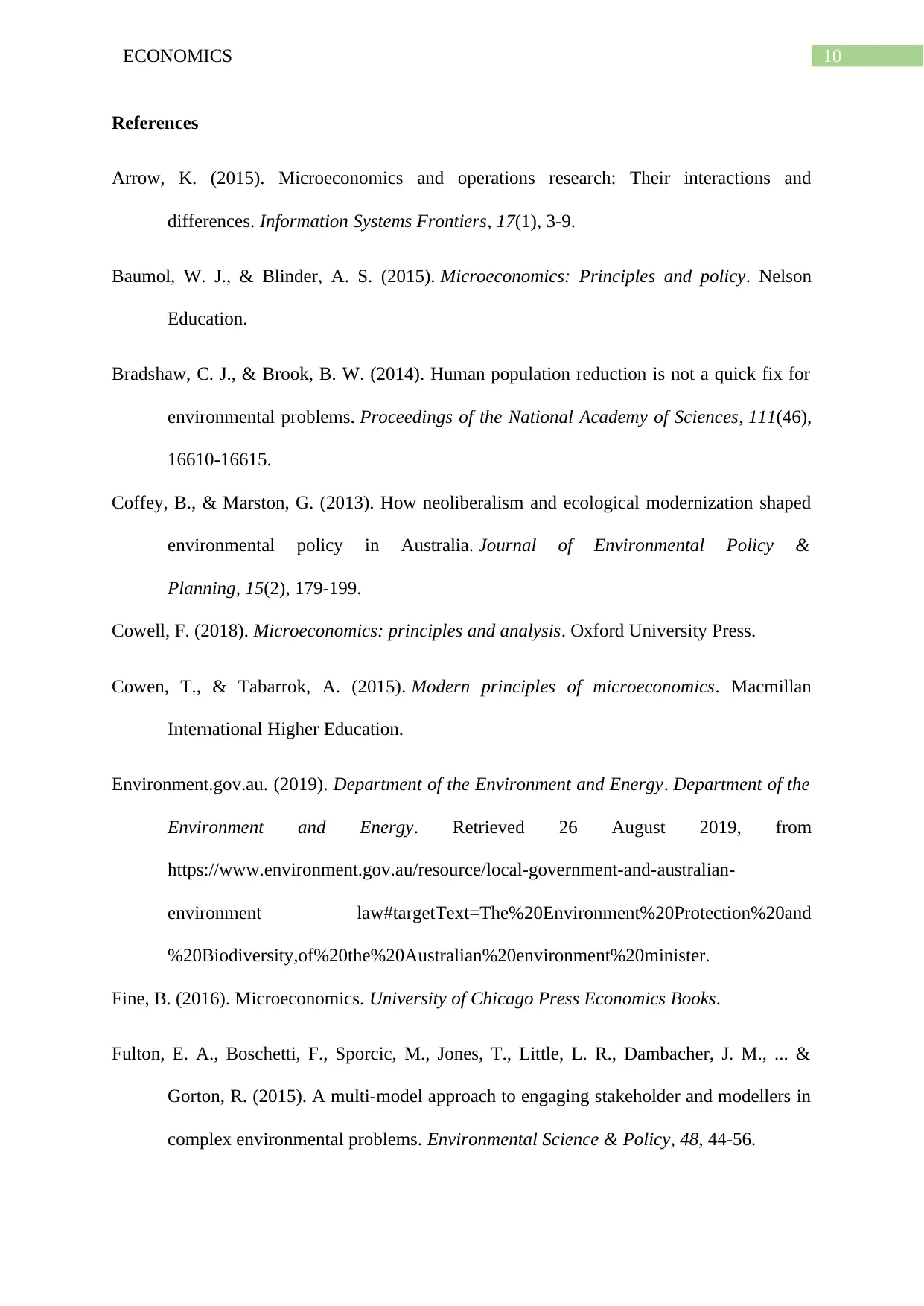
10ECONOMICS
References
Arrow, K. (2015). Microeconomics and operations research: Their interactions and
differences. Information Systems Frontiers, 17(1), 3-9.
Baumol, W. J., & Blinder, A. S. (2015). Microeconomics: Principles and policy. Nelson
Education.
Bradshaw, C. J., & Brook, B. W. (2014). Human population reduction is not a quick fix for
environmental problems. Proceedings of the National Academy of Sciences, 111(46),
16610-16615.
Coffey, B., & Marston, G. (2013). How neoliberalism and ecological modernization shaped
environmental policy in Australia. Journal of Environmental Policy &
Planning, 15(2), 179-199.
Cowell, F. (2018). Microeconomics: principles and analysis. Oxford University Press.
Cowen, T., & Tabarrok, A. (2015). Modern principles of microeconomics. Macmillan
International Higher Education.
Environment.gov.au. (2019). Department of the Environment and Energy. Department of the
Environment and Energy. Retrieved 26 August 2019, from
https://www.environment.gov.au/resource/local-government-and-australian-
environment law#targetText=The%20Environment%20Protection%20and
%20Biodiversity,of%20the%20Australian%20environment%20minister.
Fine, B. (2016). Microeconomics. University of Chicago Press Economics Books.
Fulton, E. A., Boschetti, F., Sporcic, M., Jones, T., Little, L. R., Dambacher, J. M., ... &
Gorton, R. (2015). A multi-model approach to engaging stakeholder and modellers in
complex environmental problems. Environmental Science & Policy, 48, 44-56.
References
Arrow, K. (2015). Microeconomics and operations research: Their interactions and
differences. Information Systems Frontiers, 17(1), 3-9.
Baumol, W. J., & Blinder, A. S. (2015). Microeconomics: Principles and policy. Nelson
Education.
Bradshaw, C. J., & Brook, B. W. (2014). Human population reduction is not a quick fix for
environmental problems. Proceedings of the National Academy of Sciences, 111(46),
16610-16615.
Coffey, B., & Marston, G. (2013). How neoliberalism and ecological modernization shaped
environmental policy in Australia. Journal of Environmental Policy &
Planning, 15(2), 179-199.
Cowell, F. (2018). Microeconomics: principles and analysis. Oxford University Press.
Cowen, T., & Tabarrok, A. (2015). Modern principles of microeconomics. Macmillan
International Higher Education.
Environment.gov.au. (2019). Department of the Environment and Energy. Department of the
Environment and Energy. Retrieved 26 August 2019, from
https://www.environment.gov.au/resource/local-government-and-australian-
environment law#targetText=The%20Environment%20Protection%20and
%20Biodiversity,of%20the%20Australian%20environment%20minister.
Fine, B. (2016). Microeconomics. University of Chicago Press Economics Books.
Fulton, E. A., Boschetti, F., Sporcic, M., Jones, T., Little, L. R., Dambacher, J. M., ... &
Gorton, R. (2015). A multi-model approach to engaging stakeholder and modellers in
complex environmental problems. Environmental Science & Policy, 48, 44-56.
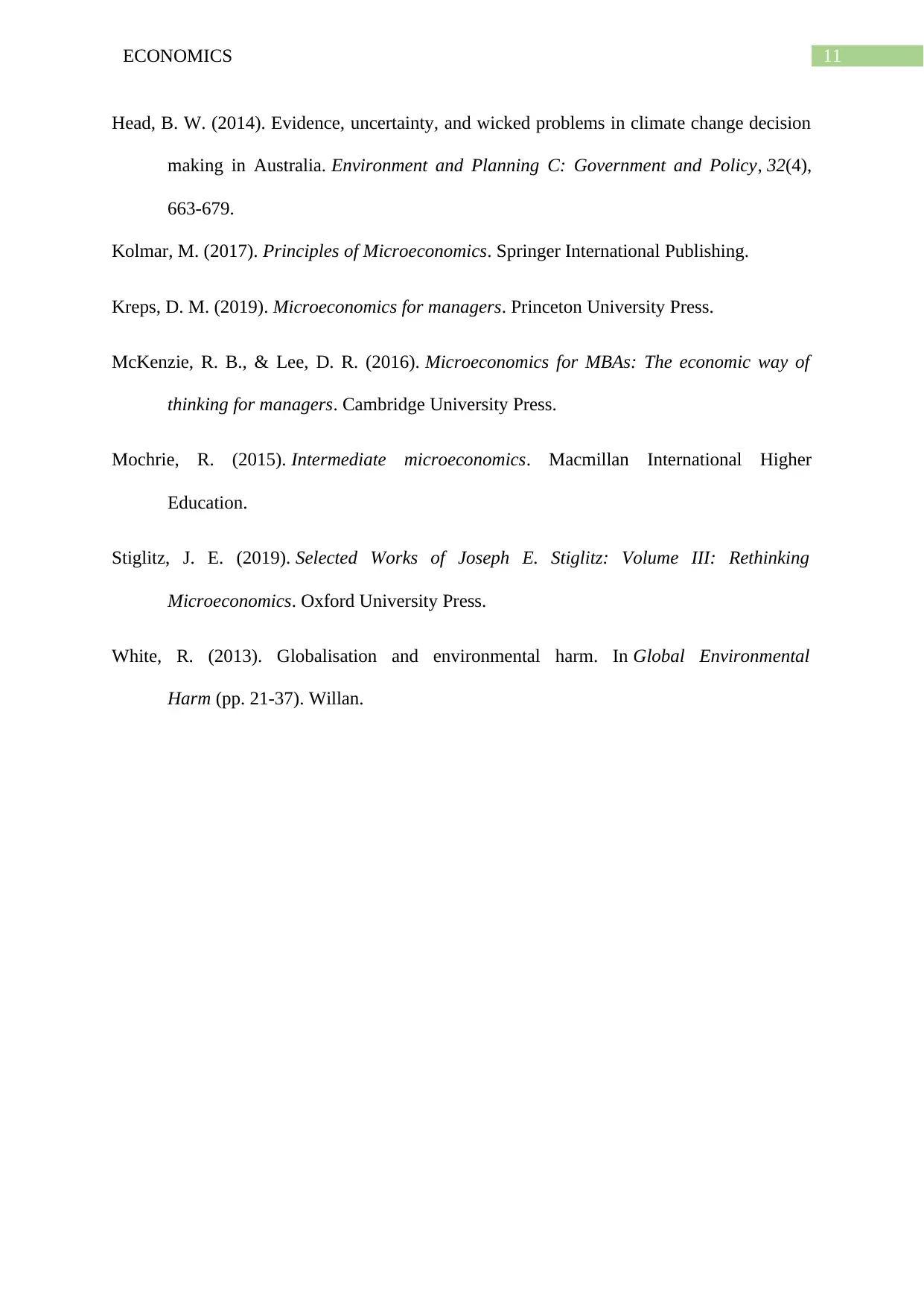
11ECONOMICS
Head, B. W. (2014). Evidence, uncertainty, and wicked problems in climate change decision
making in Australia. Environment and Planning C: Government and Policy, 32(4),
663-679.
Kolmar, M. (2017). Principles of Microeconomics. Springer International Publishing.
Kreps, D. M. (2019). Microeconomics for managers. Princeton University Press.
McKenzie, R. B., & Lee, D. R. (2016). Microeconomics for MBAs: The economic way of
thinking for managers. Cambridge University Press.
Mochrie, R. (2015). Intermediate microeconomics. Macmillan International Higher
Education.
Stiglitz, J. E. (2019). Selected Works of Joseph E. Stiglitz: Volume III: Rethinking
Microeconomics. Oxford University Press.
White, R. (2013). Globalisation and environmental harm. In Global Environmental
Harm (pp. 21-37). Willan.
Head, B. W. (2014). Evidence, uncertainty, and wicked problems in climate change decision
making in Australia. Environment and Planning C: Government and Policy, 32(4),
663-679.
Kolmar, M. (2017). Principles of Microeconomics. Springer International Publishing.
Kreps, D. M. (2019). Microeconomics for managers. Princeton University Press.
McKenzie, R. B., & Lee, D. R. (2016). Microeconomics for MBAs: The economic way of
thinking for managers. Cambridge University Press.
Mochrie, R. (2015). Intermediate microeconomics. Macmillan International Higher
Education.
Stiglitz, J. E. (2019). Selected Works of Joseph E. Stiglitz: Volume III: Rethinking
Microeconomics. Oxford University Press.
White, R. (2013). Globalisation and environmental harm. In Global Environmental
Harm (pp. 21-37). Willan.
⊘ This is a preview!⊘
Do you want full access?
Subscribe today to unlock all pages.

Trusted by 1+ million students worldwide
1 out of 12
Related Documents
Your All-in-One AI-Powered Toolkit for Academic Success.
+13062052269
info@desklib.com
Available 24*7 on WhatsApp / Email
![[object Object]](/_next/static/media/star-bottom.7253800d.svg)
Unlock your academic potential
Copyright © 2020–2025 A2Z Services. All Rights Reserved. Developed and managed by ZUCOL.





